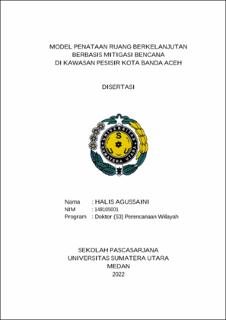| dc.description.abstract | Spatial planning aims to create a safe, comfortable, productive, and sustainable
regional space. The goal will be achieved if the potential hazards can be reduced
because sustainability and disaster mitigation are intrinsically interrelated. This
research is a type of development research that aims to build a model of spatial
planning in coastal areas within the framework of sustainable regional development
by considering disaster aspects. The model is built through four analytical tools,
namely: sustainability, land suitability, tidal inundation prone, and tsunami
inundation prone. The research stage begins with analyzing the sustainability status
of the coastal area of Banda Aceh City, making land suitability classifications,
predicting the level of vulnerability to tidal inundation and tsunamis. The results of
the sustainability analysis identified 28 sensitive attributes that have a major effect
on improving the sustainability status and 20 non-sensitive attributes that need
intervention. The results of the land suitability analysis identify the level of land
suitability for mangrove forest areas and aquaculture areas in the suitable category
(S2). The results of the tidal inundation prone analysis identified that in 2119 (100
years scenario) 30.95% of the area of Banda City was prone to tidal inundation, and
the results of the tsunami inundation prone analysis identified an earthquake
magnitude of 8.0 SR (level-1 tsunami), the level of tsunami inundation high threat
(R3) covering an area of 29.42%, medium threat level (R2) covering 52.01%, and
low threat level (R1) covering an area of 20.31% of Banda Aceh City. Based on the
formulation of the results of the analysis of the four components, a sustainable
spatial planning model based on coastal disaster mitigation of Banda Aceh City is
obtained in the form of a multi-layer tsunami defense system by combining sea
dike, mangrove forest, coastal forest, silvofishery, and elevated road. | en_US |

